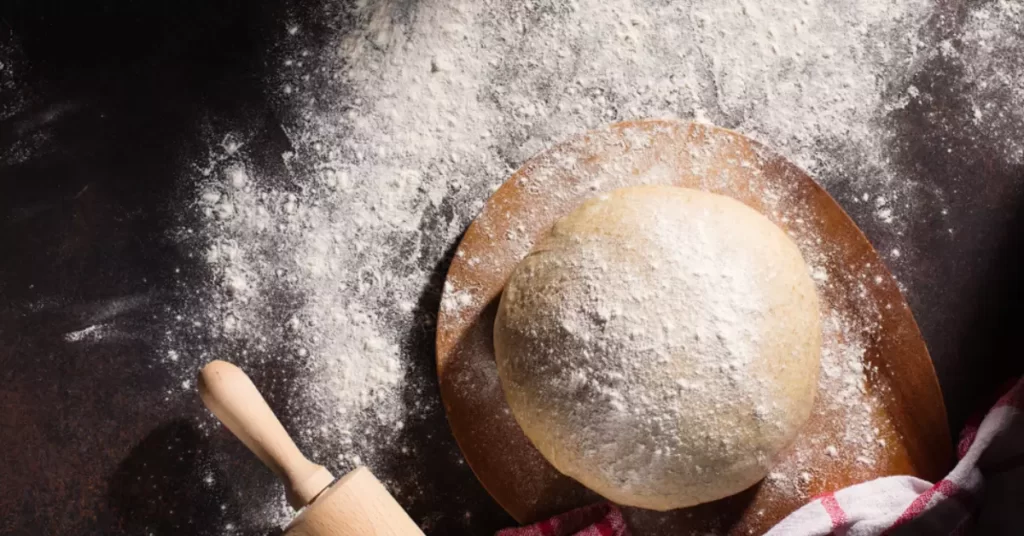The art of baking embodies a remarkable blend of science and craft. One essential ingredient that forms the backbone of many baked goods, including pizza and bread, is flour.
The choice of flour can significantly influence the texture, flavor, and overall quality of the final product. While there are various types of flours available in the market, two kinds stand out when it comes to baking pizzas and bread—pizza flour and bread flour.
Pizza flour and bread flour differ in several ways, from their protein content to the resulting texture they offer. These distinctions can impact the final product, thereby determining the best use for each type of flour.
Understanding the differences between pizza flour and bread flour is more than just an exercise in baking knowledge. It’s about empowering home bakers and cooking enthusiasts to make informed decisions, bringing their culinary creations closer to professional standards.
Pizza Flour: Overview
What is Pizza Flour?
Often referred to as ’00’ flour, pizza flour is a finely ground flour originating from Italy. This type of flour is traditionally used in making Neapolitan-style pizzas. The ’00’ designation indicates the finest grind that a flour can achieve in Italian milling.
Common Types of Pizza Flour
While ’00’ flour is the most recognized type, pizza dough can be made using various other types of flour. For example, high-gluten flour, bread flour, and all-purpose flour are also commonly employed in pizza making. Each brings its unique properties to the final product.
The Unique Characteristics of Pizza Flour
Pizza flour possesses several distinct properties that make it a favorite choice for pizza enthusiasts and professional chefs. Its protein content typically ranges around 12-13%, which is considered moderate. This protein level contributes to the dough’s extensibility, allowing it to be stretched thin without tearing. Moreover, the fine texture of ’00’ flour absorbs less water, leading to a dough that’s soft, light, and easy to knead.

Pros and Cons of Using Pizza Flour
- Produces a tender, crispy crust
- Fine texture allows for easy stretching and shaping
- Ideal for high-heat cooking methods like wood-fired ovens
- Can be harder to find and more expensive than bread flour
- May not produce the desired texture in other baked goods
Bread Flour: Overview
What is Bread Flour?
Bread flour, as the name implies, is an ideal choice for bread baking. It is milled from hard wheat varieties, resulting in a product with a higher protein content than other types of flour.
Common Types of Bread Flour
Although standard bread flour is the most common variety, there are others like whole wheat bread flour, organic bread flour, and enriched bread flour, each offering different nutritional profiles and effects on bread texture and flavor.
The Unique Characteristics of Bread Flour
Bread flour distinguishes itself with a high protein content, usually around 14-16%. This high protein level is crucial for forming more gluten, which gives the bread its strong structure and chewy texture. Furthermore, bread flour absorbs more water, leading to a dough that’s elastic and holds its shape well during baking, making it a favorite for bread types that require a significant rise.
Pros and Cons of Using Bread Flour
- Creates a chewy, substantial crust
- Versatile and suitable for various baked goods
- Readily available and affordable
- Not ideal for thin, delicate crusts
- Can produce a denser texture in some recipes
The Key Differences Between Pizza Flour and Bread Flour
Protein Content and Its Effect on Baking
Pizza flour and bread flour primarily differ in their protein content. The high protein content in bread flour results in more gluten formation, making it an excellent choice for bread that needs to rise significantly and maintain its structure. Pizza flour, on the other hand, has a moderate protein content, making it perfect for crafting a pizza crust that’s thin, flexible, and won’t tear easily.
Gluten Formation in Both Flours
Gluten formation varies between these two types of flour due to their protein content differences. Bread flour, with a high protein level, forms an extensive gluten network, leading to a chewy, substantial texture in breads. Conversely, pizza flour’s lower protein content produces less gluten, yielding a tender crust that can be stretched thin without breaking.
Taste and Texture Differences
The protein content also contributes to the difference in taste and texture. Bread flour results in a chewy, robust, and somewhat denser loaf, which many people associate with artisanal bread. In contrast, pizza made with pizza flour has a crispy, tender crust with a light, airy texture.
Best Uses for Each Type of Flour
Bread flour shines when it comes to baking bread. Its properties align well with bread types that require a significant rise and a strong gluten network, such as artisanal and yeast bread. Pizza flour, with its unique characteristics, is the star in the pizza-making process, especially when creating thin, Neapolitan-style pizzas.

Why Choose Pizza Flour for Your Pizza?
The Benefits of Using Pizza Flour in Pizza Making
Pizza flour’s unique characteristics make it an ideal choice for pizzas. With its moderate protein content, it provides the right balance between elasticity and extensibility, creating a dough that can be stretched thinly without tearing. This is particularly beneficial when crafting Neapolitan-style pizzas, known for their thin centers and puffed-up edges.
How Pizza Flour Affects the Pizza Crust
The type of flour used significantly influences the crust’s texture and flavor. With pizza flour, you can expect a crust that’s light, airy, and tender yet crispy—hallmarks of an excellent pizza crust.
Expert Opinions on Pizza Flour
Many professional bakers and pizza chefs swear by pizza flour due to its consistent performance. Its fine texture allows for smooth, easy kneading, and the resulting crust is reliably excellent in both taste and texture.
Why Choose Bread Flour for Your Breads?
The Benefits of Using Bread Flour in Bread Baking
Bread flour is a top choice for bread baking due to its high protein content. This property allows for a strong gluten network, giving the bread a sturdy structure. It’s particularly beneficial when baking yeasted bread that needs to rise significantly and hold its shape.
How Bread Flour Impacts the Texture and Taste of Bread
Bread made with bread flour tends to have a chewy texture and a strong, robust flavor. The high protein content results in more gluten formation, which adds to the bread’s chewiness and gives it a classic, hearty bread flavor.
Expert Opinions on Bread Flour
Professional bakers often prefer bread flour for its reliable performance in bread making. Its high absorbency and strong gluten formation capability make it an excellent choice for a wide variety of bread, from baguettes to sourdough.
Can You Substitute Pizza Flour for Bread Flour and Vice Versa?
Circumstances When You Might Consider Substituting
While pizza flour and bread flour each have their unique properties, there may be instances when you need to substitute one for the other. This might occur due to availability issues or specific recipe requirements. However, it’s crucial to remember that the resulting product will have differences in texture and flavor.
How to Adjust Recipes When Substituting
If substituting, remember that bread flour absorbs more water than pizza flour due to its higher protein content. Therefore, if you’re replacing pizza flour with bread flour, you may need to increase the hydration level in the recipe. Conversely, if you’re substituting bread flour with pizza flour, you may need to use less water.
Potential Outcomes and Differences in the Final Product
When substituting pizza flour for bread flour, the final product might be less chewy and have a softer crust. If you’re replacing bread flour with pizza flour in a pizza recipe, the crust might turn out chewier and less tender.
FAQs
Can I substitute all-purpose flour for pizza or bread flour?
Yes, you can use all-purpose flour as a substitute for both pizza and bread flour. However, it has a lower protein content (around 10-12%), which means it will produce a dough with less gluten and a slightly different texture. Keep in mind that the crust may be less crispy or chewy compared to using specialized flours.
Can I mix pizza flour and bread flour for my pizza dough?
Absolutely! Mixing pizza flour and bread flour can create a unique balance of texture and elasticity. Combining the two allows you to achieve a crust that falls somewhere between the tenderness of pizza flour and the chewiness of bread flour. Experiment with different ratios to find the perfect blend for your taste.
How can I adjust my dough recipe if I’m using a different type of flour?
When substituting flours, start by using the same amount called for in your original recipe. Keep an eye on the dough’s consistency, and if needed, adjust the liquid or flour gradually until the desired texture is achieved. You may also need to adjust the kneading time, as different flours require different amounts of kneading for optimal gluten development.
Final Verdict
Both pizza flour and bread flour have their unique qualities, and the choice ultimately comes down to personal preference and the desired outcome. For a delicate, crispy crust, pizza flour is the way to go, especially when using high-heat cooking methods. On the other hand, bread flour is a versatile and widely available option that creates a chewier, more substantial crust.
When it comes to crafting the perfect pizza, understanding the differences between pizza flour and bread flour is essential. By selecting the appropriate flour for your recipe, you can achieve a crust that is both delicious and tailored to your specific taste. So grab your apron, gather your ingredients, and let your culinary creativity soar as you explore the world of pizza and bread flours. Happy baking!

